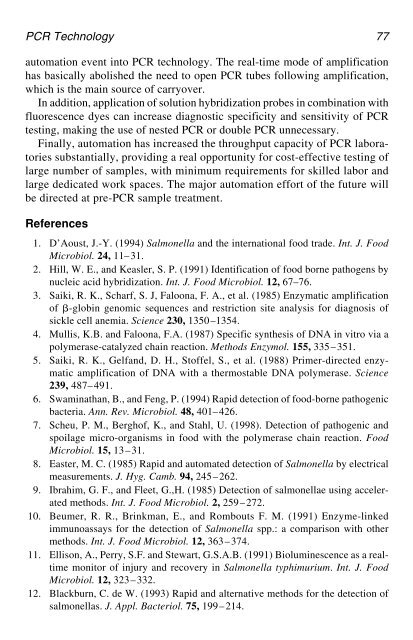PCR Detection of Microbial Pathogens PCR Detection of Microbial ...
PCR Detection of Microbial Pathogens PCR Detection of Microbial ...
PCR Detection of Microbial Pathogens PCR Detection of Microbial ...
Create successful ePaper yourself
Turn your PDF publications into a flip-book with our unique Google optimized e-Paper software.
<strong>PCR</strong> Technology 77<br />
automation event into <strong>PCR</strong> technology. The real-time mode <strong>of</strong> amplification<br />
has basically abolished the need to open <strong>PCR</strong> tubes following amplification,<br />
which is the main source <strong>of</strong> carryover.<br />
In addition, application <strong>of</strong> solution hybridization probes in combination with<br />
fluorescence dyes can increase diagnostic specificity and sensitivity <strong>of</strong> <strong>PCR</strong><br />
testing, making the use <strong>of</strong> nested <strong>PCR</strong> or double <strong>PCR</strong> unnecessary.<br />
Finally, automation has increased the throughput capacity <strong>of</strong> <strong>PCR</strong> laboratories<br />
substantially, providing a real opportunity for cost-effective testing <strong>of</strong><br />
large number <strong>of</strong> samples, with minimum requirements for skilled labor and<br />
large dedicated work spaces. The major automation effort <strong>of</strong> the future will<br />
be directed at pre-<strong>PCR</strong> sample treatment.<br />
References<br />
1. D’Aoust, J.-Y. (1994) Salmonella and the international food trade. Int. J. Food<br />
Microbiol. 24, 11–31.<br />
2. Hill, W. E., and Keasler, S. P. (1991) Identification <strong>of</strong> food borne pathogens by<br />
nucleic acid hybridization. Int. J. Food Microbiol. 12, 67–76.<br />
3. Saiki, R. K., Scharf, S. J, Faloona, F. A., et al. (1985) Enzymatic amplification<br />
<strong>of</strong> -globin genomic sequences and restriction site analysis for diagnosis <strong>of</strong><br />
sickle cell anemia. Science 230, 1350–1354.<br />
4. Mullis, K.B. and Faloona, F.A. (1987) Specific synthesis <strong>of</strong> DNA in vitro via a<br />
polymerase-catalyzed chain reaction. Methods Enzymol. 155, 335–351.<br />
5. Saiki, R. K., Gelfand, D. H., St<strong>of</strong>fel, S., et al. (1988) Primer-directed enzymatic<br />
amplification <strong>of</strong> DNA with a thermostable DNA polymerase. Science<br />
239, 487–491.<br />
6. Swaminathan, B., and Feng, P. (1994) Rapid detection <strong>of</strong> food-borne pathogenic<br />
bacteria. Ann. Rev. Microbiol. 48, 401–426.<br />
7. Scheu, P. M., Bergh<strong>of</strong>, K., and Stahl, U. (1998). <strong>Detection</strong> <strong>of</strong> pathogenic and<br />
spoilage micro-organisms in food with the polymerase chain reaction. Food<br />
Microbiol. 15, 13–31.<br />
8. Easter, M. C. (1985) Rapid and automated detection <strong>of</strong> Salmonella by electrical<br />
measurements. J. Hyg. Camb. 94, 245–262.<br />
9. Ibrahim, G. F., and Fleet, G.,H. (1985) <strong>Detection</strong> <strong>of</strong> salmonellae using accelerated<br />
methods. Int. J. Food Microbiol. 2, 259–272.<br />
10. Beumer, R. R., Brinkman, E., and Rombouts F. M. (1991) Enzyme-linked<br />
immunoassays for the detection <strong>of</strong> Salmonella spp.: a comparison with other<br />
methods. Int. J. Food Microbiol. 12, 363–374.<br />
11. Ellison, A., Perry, S.F. and Stewart, G.S.A.B. (1991) Bioluminescence as a realtime<br />
monitor <strong>of</strong> injury and recovery in Salmonella typhimurium. Int. J. Food<br />
Microbiol. 12, 323–332.<br />
12. Blackburn, C. de W. (1993) Rapid and alternative methods for the detection <strong>of</strong><br />
salmonellas. J. Appl. Bacteriol. 75, 199–214.






